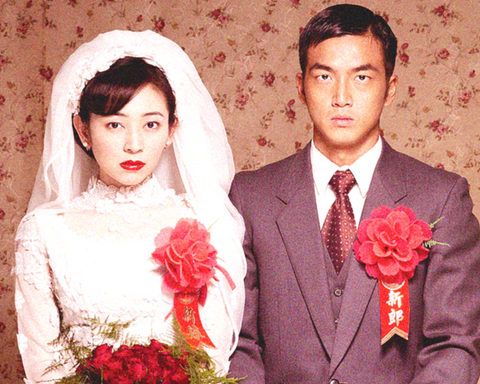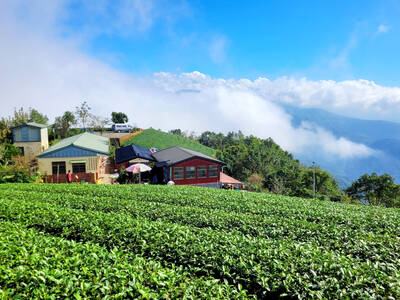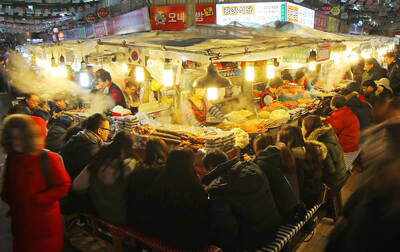This week, Tanshui is once more being celebrated in the reincarnation of Godot Theatre Company's perennial favorite Little Town of Tanshui.
Adapted from Thornton Wilder's Our Town, this is the play's fifth incarnation in Taiwan, which was first introduced on the stage for the Taiwan audience in 1989 and was last seen in 1999.
Why did writer and director James Liang (梁志民) feel the need to reinvent the story again?

PHOTO COURTESY OF GODOT
"It's been 17 years since audiences in Taiwan first experienced the story on stage," explains Godot's head of
marketing Alice Yang (楊玉玲).
"In each version, the presentation was always different to reflect the different actors and different tones. The play has always been very well received in all its different forms over the years so that audiences actually look forward to its next incarnation. For our performance this year, we wanted to capture the essence of Tanshui in a poetic, almost dream-like way, and to do so we used high-powered projectors to present subtle but very atmospheric paintings in the background as the story unfolds."
Set in the 40s and 50s in the then quiet port town of Tanshui, the story is told through a storyteller played by Tao Da-wei (陶大偉), who in his theaterical debut has the ability to pause, fast-forward, and rewind the events seen on stage. With him, we observe the characters in this town, mainly two families, the Chens and the Ais, and their children, particularly Shao-wei and Jasmine. The story follows their lives through 20 years of childhood, courtship, marriage and ends with Jasmine recollecting their lives together on Shao-wei's tomb.
In adapting the story for Taiwan, one might wonder, why Tanshui?
"Tanshui at that time was at its start of development," explains Yang.
"There were people arriving from the mainland, the local residents and the Mackay Memorial Hospital (馬偕醫院) doctors. It wasn't a rich or politically important town, and yet they all worked together harmoniously and over decades dedicated their lives to the land and slowly breathed life into the Tanshui we know today. In the process they showed the best side of humanity."
One of the key attractions of this year's variation is Tao who, himself a famous singer and father of pop icon David Tao, expressed his strong desire to appear for the first time on stage and to infuse the story with his unique trademark humor.
"This is ultimately, a simple story of life," says Yang. "There's a symbolic moment in the play when one of the characters gives birth to a baby, a magni-ficent moment of welcoming a new life into the world, only for the mother to die moments later. This play hopes to highlight the beauty, tragedy, joys and sorrows that occur for everyone in everyday life, and of course to remind all of us to cherish the moment."
What: Godot Theater Company's Little Town of Tanshui (
Where: Sun Yat-sen Memorial Hall, 505, Renai Rd, Sec 4, Taipei (
When: Tonight, tomorrow and Sunday at 7pm and tomorrow and Sunday at 2pm. For performances in other cities, visit www.godot.org.tw
Tickets: NT$400 to NT$2,500 and are available through www.artsticket.com.tw

In recent weeks the Trump Administration has been demanding that Taiwan transfer half of its chip manufacturing to the US. In an interview with NewsNation, US Secretary of Commerce Howard Lutnick said that the US would need 50 percent of domestic chip production to protect Taiwan. He stated, discussing Taiwan’s chip production: “My argument to them was, well, if you have 95 percent, how am I gonna get it to protect you? You’re going to put it on a plane? You’re going to put it on a boat?” The stench of the Trump Administration’s mafia-style notions of “protection” was strong

Every now and then, it’s nice to just point somewhere on a map and head out with no plan. In Taiwan, where convenience reigns, food options are plentiful and people are generally friendly and helpful, this type of trip is that much easier to pull off. One day last November, a spur-of-the-moment day hike in the hills of Chiayi County turned into a surprisingly memorable experience that impressed on me once again how fortunate we all are to call this island home. The scenery I walked through that day — a mix of forest and farms reaching up into the clouds

With one week left until election day, the drama is high in the race for the Chinese Nationalist Party (KMT) chair. The race is still potentially wide open between the three frontrunners. The most accurate poll is done by Apollo Survey & Research Co (艾普羅民調公司), which was conducted a week and a half ago with two-thirds of the respondents party members, who are the only ones eligible to vote. For details on the candidates, check the Oct. 4 edition of this column, “A look at the KMT chair candidates” on page 12. The popular frontrunner was 56-year-old Cheng Li-wun (鄭麗文)

“Eighteen years ago, people didn’t even know the name of this ingredient,” says 58-year-old Gil Sa-hyeon, holding up a cluster of dried brownish stems. “Now it’s everywhere.” His shop, Joseon Yakcho, sits in the heart of Seoul’s Yangnyeongsi Market, South Korea’s largest traditional medicinal herb market, its streets lined with shops displaying buckets of herbs such as licorice root and cinnamon bark that spill on to the pavements, filling the air with their distinct, earthy aroma. The ingredient Gil is referring to is hovenia dulcis, known in Korean as heotgae — the oriental raisin tree that’s become the cornerstone of South Korea’s